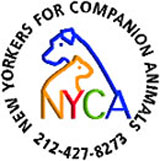| 
|
Chapter 21. Getting Out of the Killing Business?
Early in the 1990's, the ASPCA which then had responsibility for animal control in New York City expanded. There had been talk that the ASPCA no longer wanted this responsibility as the reality of being a "kill shelter" affected both, reputation and donations. The old shelter at 440 East 92nd street was closed and a new animal control shelter was opened at 326 East 110th street. Meanwhile, a new building was being erected at 420 East 92nd Street that would serve as the ASPCA's new headquarters, a small "no kill" shelter and its hospital. It was reported that the ASPCA would run the new animal control (euthanizing) shelter in East Harlem for only a couple of years and it would then be taken over by the city. The ASPCA wanted to get out of the "killing business."
We in the animal community were not happy with the news for two reasons. First, the new animal control shelter was located in a run-down, undesirable area of the city where few people, other than area residents ventured to go. This location would not be attractive to potential adopters. Secondly, media reports on the story were sugarcoated and exaggerated. ASPCA press releases and headlines blared, ASPCA to get out of killing business! Only in the very fine print, would one understand that New York City would still continue to kill homeless pets. The killing would simply be more hidden by being moved to East Harlem. Sadly, most people, failing to read the fine print, interpreted the media reports to mean that New York would soon be "no kill." All this was wishful thinking, not reality.
When the ASPCA opened its new animal control (pound) facility on East 110th Street, members of the press and the animal community were invited for a "tour." Unfortunately, the new shelter was far inferior to the old. The building had been renovated from an old warehouse. Dismal, windowless animal wards were located on two floors. Lighting was dim, ventilation and drainage systems were poor, there was no soundproofing and cages were small and poorly constructed. There was nothing cheerful or inviting about this place, which for the most part, served as a place cats and dogs were dropped off to die.
Nevertheless, the ASPCA attempted to put a good "spin" on the situation. According to its PR, extra cages and two new shelters would mean more animals saved and adopted. No-kill shelters and rescue groups (like ours) were invited to "pull" adoptable animals from the 110th street location in order to save more lives. While there was some truth to these claims and while offers to work with the rescue community were a step in the right direction, it was overall, a very troubling development. Something that would in fact, take years to get off the ground correctly and humanely. At the very least, something needed to be done to provide the animals with better care and a more healthy, humane environment. In the upstairs dog holding wards, for example, signs were posted on the doors, Warning: Ear Protection Required . The earsplitting noise from dozens of highly stressed, barking dogs could be damaging to human ears. But, what did it mean for the dogs who would have to be held in this decrepit environment for weeks or months until a court cruelty or eviction case was resolved? One shuddered to think.
The cold, bitter February day Anita and I visited the new facility on 110th Street was, in most ways, a grim and sobering experience for us. The sights of so many desperate and mostly doomed animals in generally appalling conditions was depressing and haunting. We in the rescue and advocacy community indeed had our work cut out for us. The situation was overwhelming.
As we walked down 110th Street and headed south on First Avenue, we also became aware of a number of junk and used car lots in the neighborhood. Chained up dogs barked frantically at us from behind wire gates. Bits of snow and freezing ice clung to the grounds. Gray, threatening skies overhead served only to add a note of further grimness to the day.
Anita and I walked down First Ave towards 109th Street. As we passed one of the junk lots, we noted a scraggly brown tiger cat tiptoeing over mounds of broken glass, debris and frozen ice. The cat briefly looked our way and then quickly skidded behind some discarded wood parts. Anita and I walked into a nearby bodega and picked up some cat food, fully figuring that the cat would be gone by the time we got back to the junk lot.
But, she wasn't. Peeking out from behind some slabs of wood, we saw two very large, green, frightened eyes staring at us.